This post contains affiliate links and I will be compensated if you make a purchase after clicking on my links.
Meet the Persian Cat Breed: An Introduction to Their Enchanting World
Persian cats have long been a symbol of aristocracy, once favored by royal families across the globe. These traditional or Doll Face Persians are celebrated for their balanced features and amiable temperaments.
Though they maintain a composed exterior, don’t be fooled—Persians possess a playful spirit that endears them to their human companions.
As we delve into the world of these majestic cats, we’ll start with the original Persian breed, exploring its rich history and charming characteristics. Later, we’ll explore the various types of Persian cats, each with unique traits shaped by selective breeding.

History and Origin of Persian Cats
The story of the Persian cat is like a whiskered walk through history. These feline divas didn’t just pop up on the catwalk overnight; they have a lineage that’s as rich and luxurious as their coats!
Persian Cats: From Ancient Iran to European Nobility
The journey of Persian cats began in the mystic dunes of Persia (modern-day Iran). These cats were first introduced to Europe in the 1600s, and it was love at first sight. With their long, flowing coats and dignified poise, they quickly became the darlings of the aristocracy.
Picture this: Persian cats lounging on the lavish carpets of Italian nobles or being painted by Dutch masters. Quite the life, right?
The Evolution of the Persian Cat Breed
Over the centuries, Persian cats have gone through quite the makeover. Early Persians had a more rugged look, suited to their Middle Eastern origins. But as breeders began to favor certain traits, these cats transformed into the fluffy, round-faced beauties we know today.
Persian Cats in Royal Courts: A History of Prestige
By the 19th century, Persian cats were a hit in the show circuits, especially in Victorian England. Their popularity soared, making them a symbol of luxury and elegance.
Fun fact: They were even one of Queen Victoria’s favorite breeds!
Modern Persian Cats: A Journey Through Time
Today, these feline celebs continue to steal the show with their serene nature and plush appearance. They’ve come a long way from the deserts of Persia to the cushy pillows of homes worldwide.
Persian cats remind us of the elegance of history, making them not just pets, but living, purring, and occasionally napping pieces of art.
Understanding Persian Cats: Key Breed Characteristics
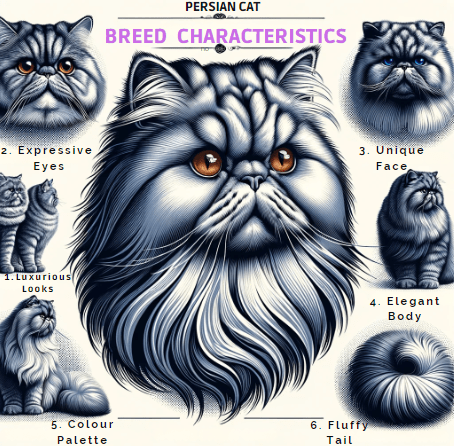
- Luxurious Looks of Persian Cats: The crowning glory of a Persian cat is its long, lush coat, resembling a permanent fur coat that requires regular grooming. This magnificent mane varies in texture, from silky smooth to cottony soft, demanding constant care.
- Expressive Eyes of Persian Cats: Persian cats boast large, expressive eyes, which seem to hold centuries of feline wisdom. These captivating orbs often shine in shades of deep copper, vibrant orange, sparkling blue, or occasionally, a mix of both, making them truly eye-catching.
- Distinctive Face Shape of Persian Cats: A key feature of Persian cats is their unique face profile. With a short muzzle and a round head topped with small, rounded ears, they exude a look of perpetual sweetness, always camera-ready.
- Regal Body Structure of Persian Cats: Persians possess a sturdy, medium-to-large body that exudes an air of dignified grace. Although their strong legs don’t make them the quickest cats, they contribute to their regal posture.
- Diverse Colors of Persian Cats: Persian cats come in a vast array of colors. Options range from the striking shaded silver, which appears moonlit, to the silver shaded, featuring a delicate silver overlay on a creamy base.
- Majestic Tails of Persian Cats: Completing their regal appearance, Persian cats flaunt long, fluffy tails, reminiscent of a plush feather boa, which adds a touch of majesty to their overall presence.
The Physical Traits and Growth of Persian Cats
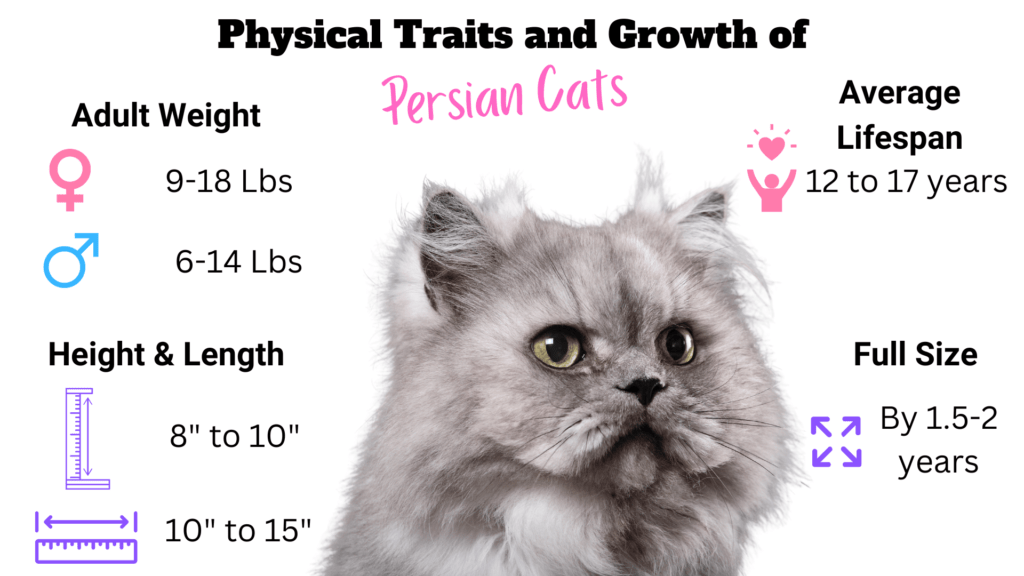
Exploring the physical dimensions and growth patterns of Persian cats offers essential insights into what owners can expect as these majestic felines grow. Here’s a comprehensive look at their key physical traits:
Adult Weight and Size
Male Persian Cats generally weigh between 9 to 18 pounds, while female Persians tend to be lighter, ranging from 6 to 14 pounds. Standing about 8 to 10 inches at the shoulder, these cats typically measure 10 to 15 inches in length from nose to the base of the tail, not including their luxurious tails.
Lifespan and Growth
Persian cats usually enjoy a long lifespan, living on average 12 to 15 years, sometimes even longer with proper care. They reach their full size by the age of 1.5-2 years, but their weight and lush coat continue to develop until around 4 years old.
Understanding Persian Cat Personality: What to Expect
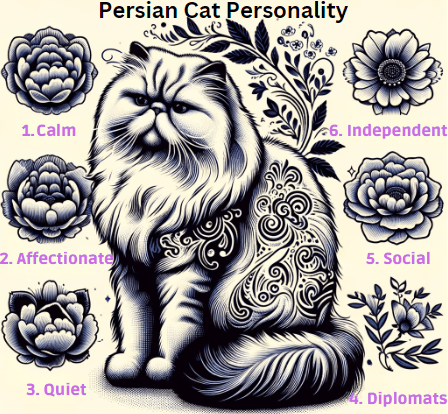
Persian cats also possess a temperament that’s nothing short of royal. Let’s dive into the world of their personalities and discover how these furry monarchs rule their human kingdoms.
- Calm Demeanor of Persian Cats: Persian cats are the epitome of feline zen. Known for their calm and laid-back demeanor, they’re often found lounging in their favorite spots, observing their domain with a serene gaze. Think of them as the meditative monks of the cat world, bringing a peaceful vibe to any room they grace.
- Affectionate Nature of Persian Cats: Don’t let their regal bearing fool you – Persians are suckers for affection and often show their love openly. They thrive on being pampered and petted by their human companions, frequently seeking out your lap for a cozy cuddle session.
- Quiet Companionship of Persian Cats: Persian cats are the strong, silent type and are not known for being vocal. When they do speak, it’s with a soft, melodious meow that seems perfectly designed not to disturb the tranquility of their kingdom.
- Diplomatic Behavior of Persian Cats: In the presence of other pets, Persian cats show remarkable diplomacy. They generally get along well with other animals, preferring a calm and respectful introduction. They avoid disturbances but maintain their dignity and poise, even with boisterous housemates.
- Social Etiquette of Persian Cats: Persians might not be the life of the party, but they do enjoy socializing in their own dignified way. They tend to form strong bonds with their family members and can be surprisingly playful, albeit in a gentle manner.
- Independence of Persian Cats: While they cherish attention, Persian cats also value their independence. They are among the breeds that are content to spend time alone and do not require constant interaction.
Persian cats are the gentle, affectionate, and serene companions that can add a touch of tranquility and a lot of heart to any home. They’re the furry embodiment of grace and poise, making every day a little more majestic.
Healthcare for Persian Cats: Ensuring Optimal Well-being
Caring for a Persian cat is like being entrusted with a precious, living treasure. It’s not just about keeping them looking fabulous – it’s about ensuring they lead a happy, healthy life.
Addressing Common Health Issues in Persian Cats
- Respiratory Issues: Due to their distinctive face shape, some Persians can have breathing difficulties. Keeping a watchful eye on their breathing and consulting a vet for the best care is key.
- Dental Dilemmas: Those cute, squished faces can sometimes lead to dental issues. Regular dental check-ups are crucial to keep their pearly whites in tip-top shape.
- Kidney Stones and Cystitis: Persians are more prone to kidney issues. Ensuring they have a proper diet and plenty of water can help keep their kidneys purring.
Optimal Nutrition for a Persian Cat’s Health
- High-Quality Diet: A diet rich in high-quality protein is essential for maintaining their luxurious coat and overall health. Buy only the best food for your kitty.
- Hydration is Key: Always have fresh water available. Consider a cat water fountain to encourage them to drink more – they’re a bit like the royalty preferring their water running!
- Portion Control: Keep an eye on their food intake to prevent obesity, which can lead to other health issues.
Important: Regularly weighing your Persian cat and noting their weight is crucial. Compare these figures with the ideal estimates from our Persian Cat Weight Calculator and consistently check their Body Score Condition. This ensures they maintain optimal health and weight.
Grooming Essentials for Maintaining a Persian Cat’s Coat
- Daily Brushing: Their long, glorious fur requires daily brushing to prevent mats and tangles, making it crucial to brush them correctly
- Bathing: A monthly bath can help keep their coat shiny and clean. Remember, the right shampoo makes all the difference – no commoners’ stuff for these regal felines!
- Nail Trimming: Regular nail trims are important to keep their claws in check – even royalty needs a good manicure!
- Eye Care: Due to their brachycephalic face structure, Persians often have tear staining. Gently cleaning around their eyes regularly can prevent this.
Daily Life with a Persian Cat: Tips and Insights
Living with a Persian cat is akin to sharing your space with a dignified, furry member of royalty. They may not don actual crowns, but their majestic demeanor speaks volumes. In crafting the perfect environment for these elegant companions, consider the following essentials.
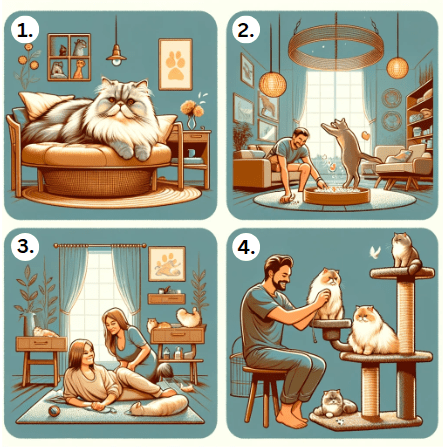
Creating the Perfect Home for Your Persian Cat
Persian cats flourish in tranquil surroundings. They prefer a quiet, peaceful atmosphere where they can lounge and observe with minimal disturbance. Providing them with cozy nooks offers a safe haven for them to relax and oversee their surroundings. Since their luxurious fur can make them prone to overheating, maintaining a comfortable room temperature is also crucial.
Establishing a Routine: Exercise and Daily Care for Persians
Despite their laid-back nature, Persians enjoy engaging in gentle play. Light playtime, like feather toy interactions or soft ball chases for 20-30 minutes daily, caters to their need for activity without being overly strenuous.
Establishing a consistent daily routine, including set times for feeding, grooming, and play, helps them feel secure and content. Regular grooming is particularly important, serving both as essential care for their long fur and as an opportunity for bonding.
Socializing Your Persian Cat: Tips for a Well-Rounded Pet
When it comes to meeting new pets or family members, a gradual and calm introduction is key. Persians, with their composed nature, can adapt well to new acquaintances when given time and space. Surprisingly, they’re also receptive to training.
While Persian cats may not be the best breed for learning tricks, with patience and positive reinforcement, teaching them basic commands or playful tricks can still be a rewarding experience. Although they don’t seek constant social interaction, they value and enjoy regular, gentle affection, which reinforces their sense of belonging and security in the home.
Breeding Persian Cats: A Look at Genetics and Standards
Delving into the world of Persian cat breeding is more than just a nod to their stunning beauty. It’s a journey of balancing art and science, where every decision impacts the grace and well-being of these exquisite felines.
Breeding Insights: The Art of Producing Healthy Persians
Selecting the perfect pair to avoid common health snags like respiratory or kidney issues is like a matchmaker’s dance – intricate and essential. Breeding Persians is an art form that calls for a deep dive into their genetic blueprint, ensuring every litter is a testament to the breed’s health and temperament.
Genetics of Persian Cats: A Closer Look
The genetic landscape of Persian cats is fascinating. Take their luscious fur, for example – a recessive trait that requires both parents to pass it on. And their signature flat faces? It’s about finding the sweet spot in breeding to maintain that distinctive look without compromising their well-being.
Adopting or Buying a Persian Cat: Guidance for Prospective Owners
Whether you’re looking to adopt or buy a Persian cat, it’s like beginning an enchanting journey with a furry companion. Here are some nuggets of wisdom to help you navigate this exciting path.
Adoption Tips
- Rescue with Love: Consider adopting a Persian cat from a rescue or shelter. It’s not just about giving a cat a home; it’s about gaining a loyal, fluffy friend.
- Know Their Story: When adopting, try to learn as much as possible about the cat’s history and health. This helps in preparing for any special care they might need.
- Patience is Key: Remember, it might take some time for an adopted Persian to adjust to their new kingdom. Patience and gentle care will help them feel at home.
Buying from Breeders
- Seek Reputable Breeders: If you’re leaning towards buying a Persian cat, look for breeders who prioritize the cats’ health and well-being. They should be knowledgeable, transparent, and willing to answer all your questions.
- Health First: A good breeder will provide health clearances and genetic testing results to prove their cats are free from common genetic health issues.
- Visit in Person: If possible, visit the breeder’s location. This gives you a chance to see the conditions the cats are raised in and meet the parent cats.
Ethical Considerations
- Avoid Impulse Buys: Owning a Persian cat is a long-term commitment. Avoid making an impulsive decision based on their looks alone.
- Support Responsible Practices: By choosing ethical breeders or adoption, you’re advocating for responsible pet ownership and breeding practices.
Must-Have Gadgets and Accessories for Your Persian Cat
In the world of Persian cats, where grace and technology intertwine, there are some fantastic gadgets and accessories that can add a touch of innovation to their care and entertainment. Let’s dive into the techy treats that can make life with a Persian cat even more delightful.
1. Advanced Grooming Tools for Persian Cats
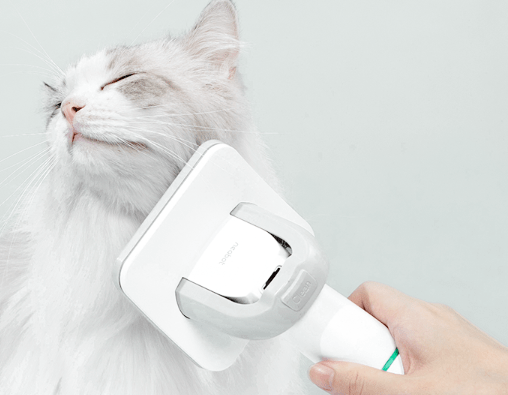
Given their luxurious coats, grooming is a top priority for Persian cats. Consider investing in an electric grooming brush or a high-quality pet vacuum cleaner designed for long fur. These tools not only ease the grooming process but also turn it into a fur-tastic experience for both you and your furry monarch.
2. Interactive Play: Choosing Toys for Persian Cats
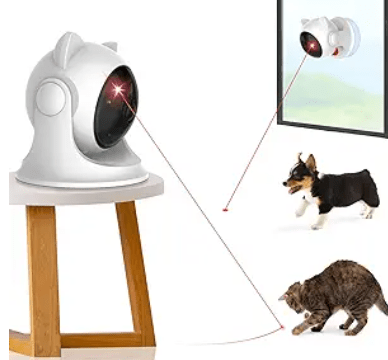
Persian cats, known for their serene nature, might not sprint on a cat wheel, but they love brain-engaging toys. Opt for things like puzzle feeders or laser toys for gentle exercise that keeps them both mentally and physically active.
Given their less active lifestyle, check out our article on the Alternatives to Cat Exercise Wheels, where we explore interactive toy options that are more in line with the Persian cat’s leisurely pace.
3. Health Monitoring Gadgets
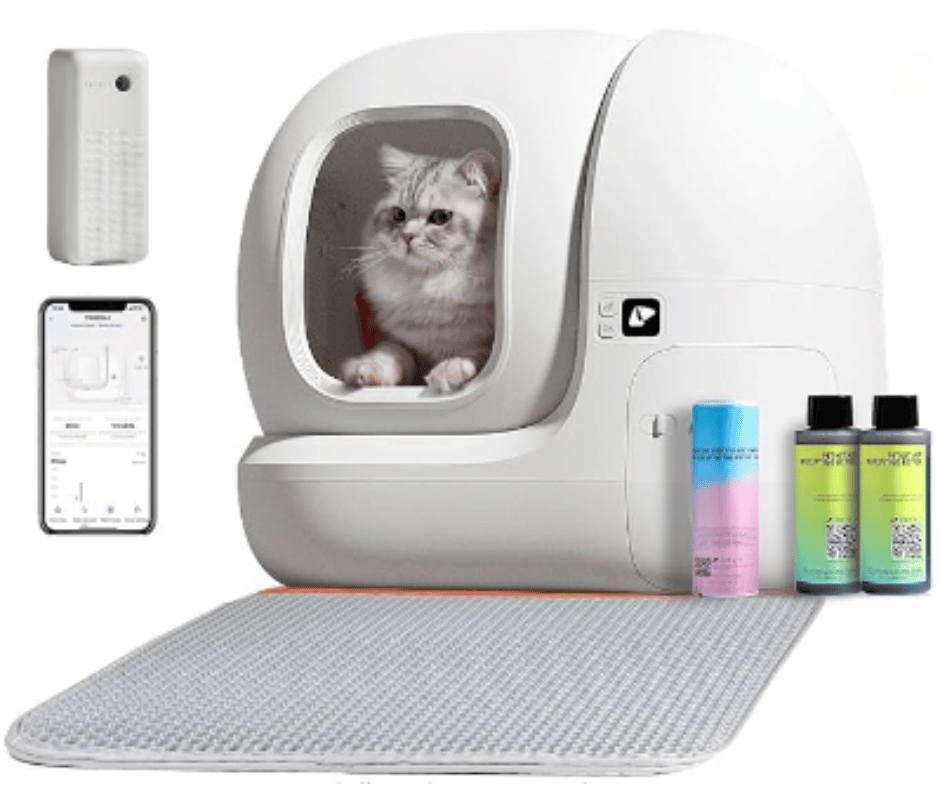
Keeping a tab on your Persian’s health is easier with the latest tech. Think smart litter boxes that monitor waste for signs of health issues, or wearable pet health trackers that keep an eye on their activity levels and rest patterns.
4. Enhancing Comfort: Accessories for Your Persian’s Well-being
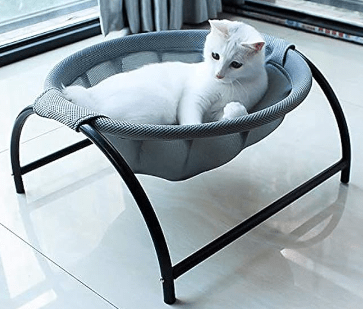
From heated cat beds to automated water fountains, and even cozy cat desk beds, there are numerous gadgets designed to pamper your Persian cat. These accessories not only enhance their comfort but also cater to their royal standards.
Imagine your Persian lounging on a plush desk bed, keeping you company while you work, embodying the perfect blend of companionship and regal leisure.
Varieties of Persian Cats: Exploring Different Types
While we have delved into the enchanting world of the traditional or Doll Face Persian cat, known for its balanced features and amiable temperament, the Persian breed also includes a stunning array of types, each slightly differing from the original.
These variations, developed through selective breeding, each possess their own unique charm and characteristics, offering a broader spectrum of this majestic breed.
1. Peke-Face Persians
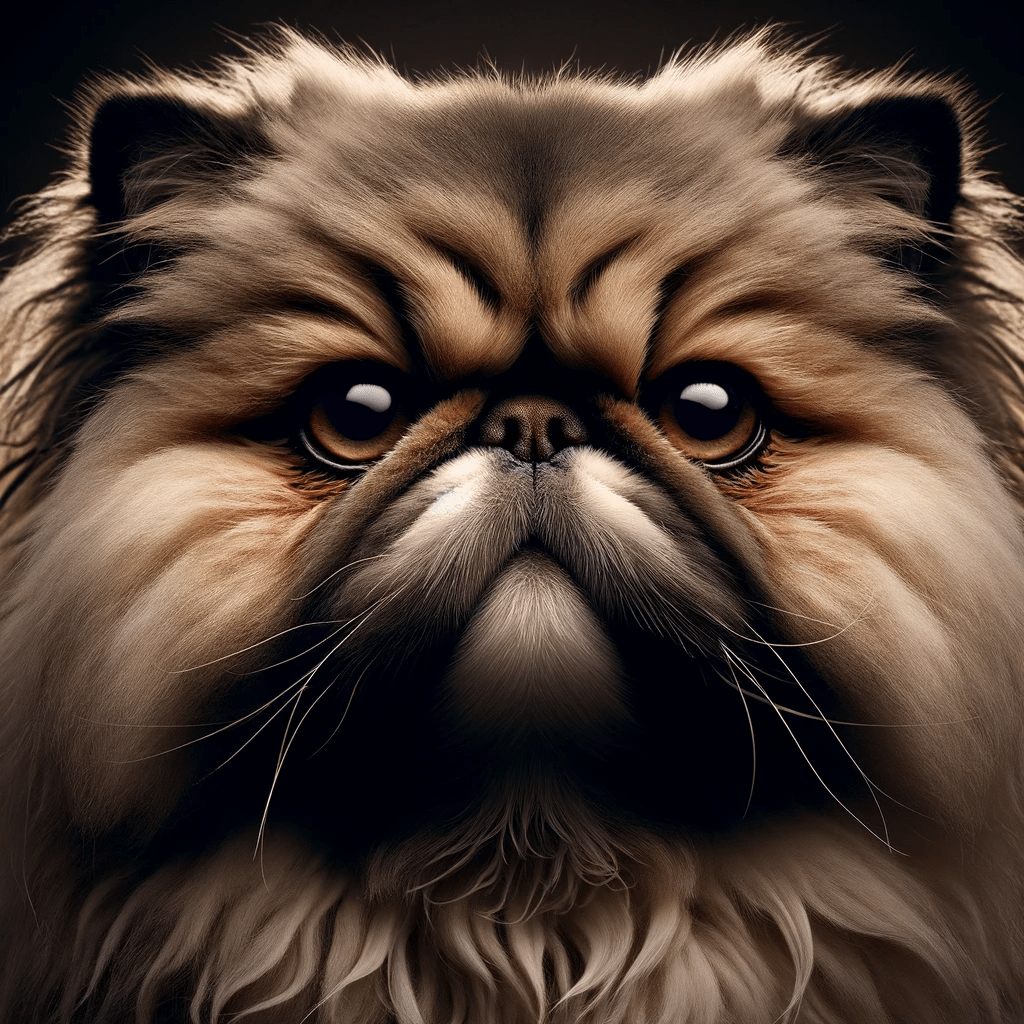
Peke-Face Persian cats are recognized for their extremely flat faces, a characteristic resulting from selective breeding. These Persians have a more pronounced brachycephalic feature, resembling the facial structure of a Pekingese dog.
2. Chinchilla Longhair Persians
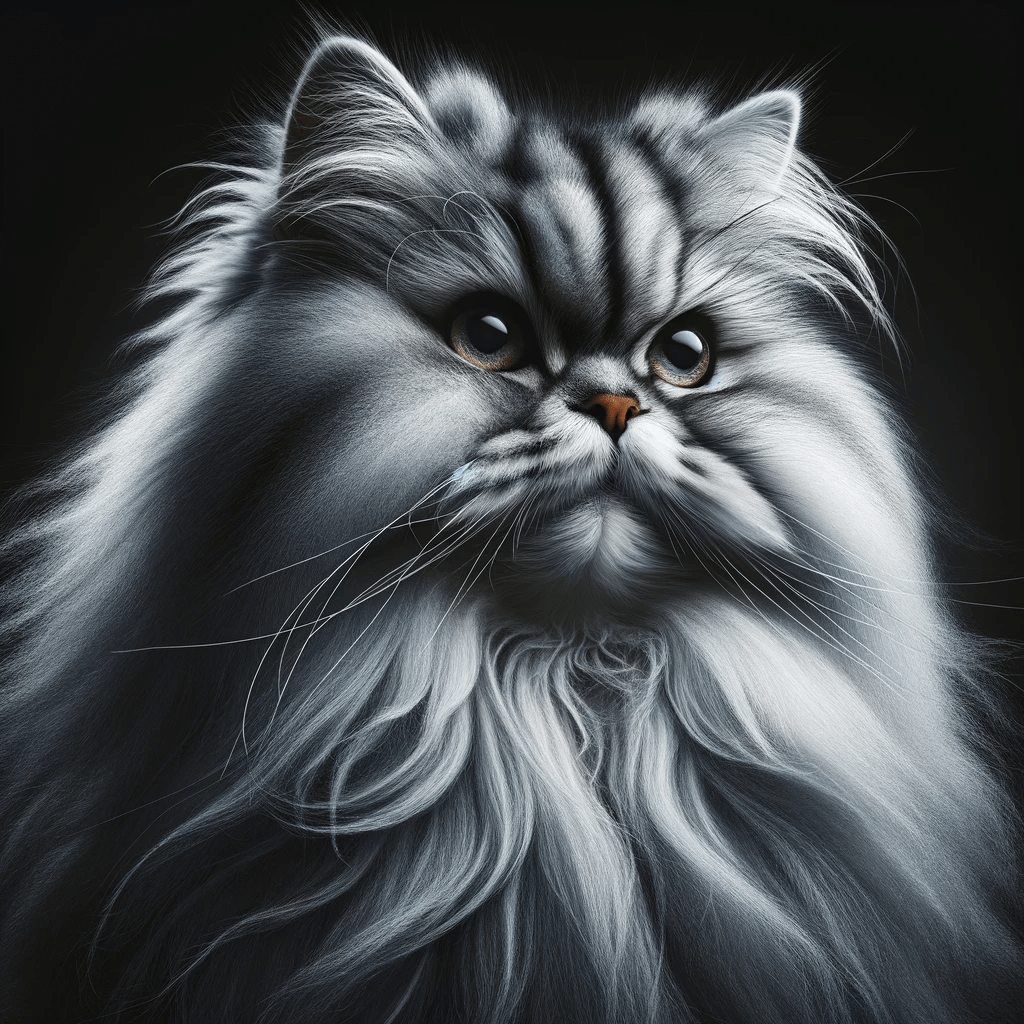
A shimmering vision, the Chinchilla Longhair (or Sterling) has a silvery coat with black tips. This type presents a glamorous, sparkling appearance, making them a striking variant of the Persian family.
3. Himalayan Persians

A beautiful blend, the Himalayan Persian is a cross between Siamese and Persian cats. They have the long fur of Persians and the striking color points (ears, face, paws, and tail) of Siamese cats.
4. Exotic Shorthair Persians
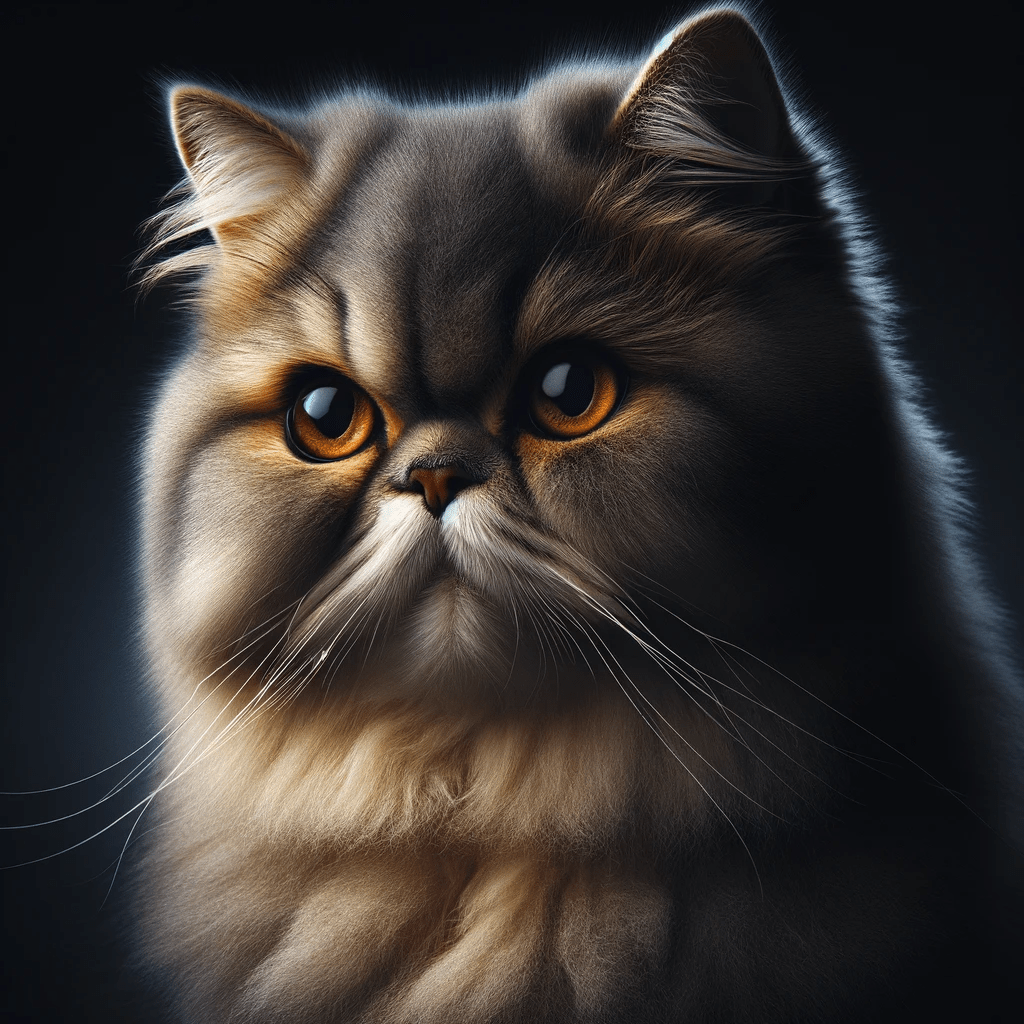
Often referred to as the short haired Persian, the Exotic Shorthair was bred as an alternative for those who love Persians but prefer less grooming. They have a similar temperament and physical build but with a shorter, easier-to-maintain coat.
5. Toy and Teacup Persians
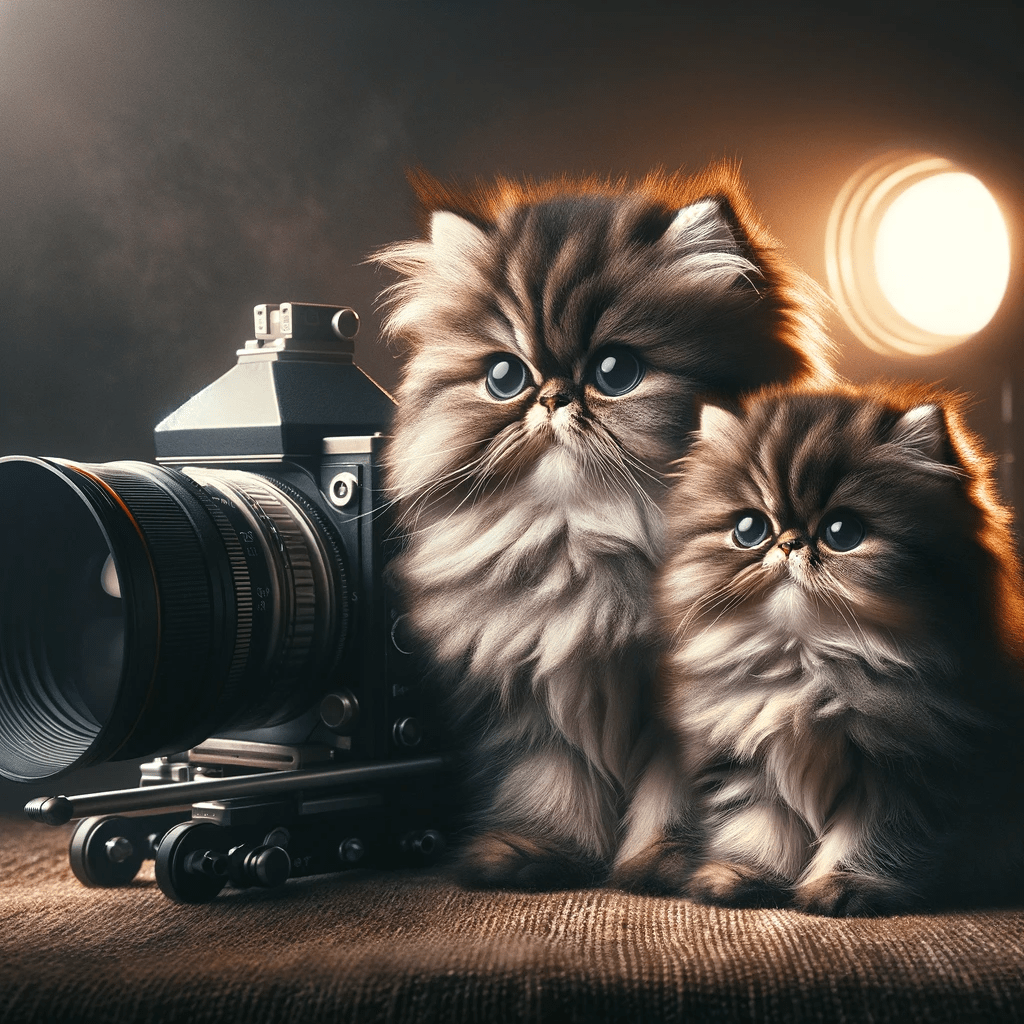
These are smaller versions of the standard Persian, bred specifically for their diminutive size. They offer all the elegance and personality of a Persian cat in a more compact package.
Wrapping Up: Celebrating the Splendor of Persian Cats
In the plush world of Persian cats, we’ve journeyed through their history, characteristics, and care, uncovering the elegance and charm of these serene felines. From their distinct appearance to their dignified behavior, and the special attention their health and grooming require, Persian cats stand as a symbol of grace in the feline world.
Whether through adoption or integrating modern tech into their care, embracing the life with a Persian cat is to welcome a touch of majesty and affection into your home.
Remember, it’s not just about finding the right cat; it’s about being the right human for them.

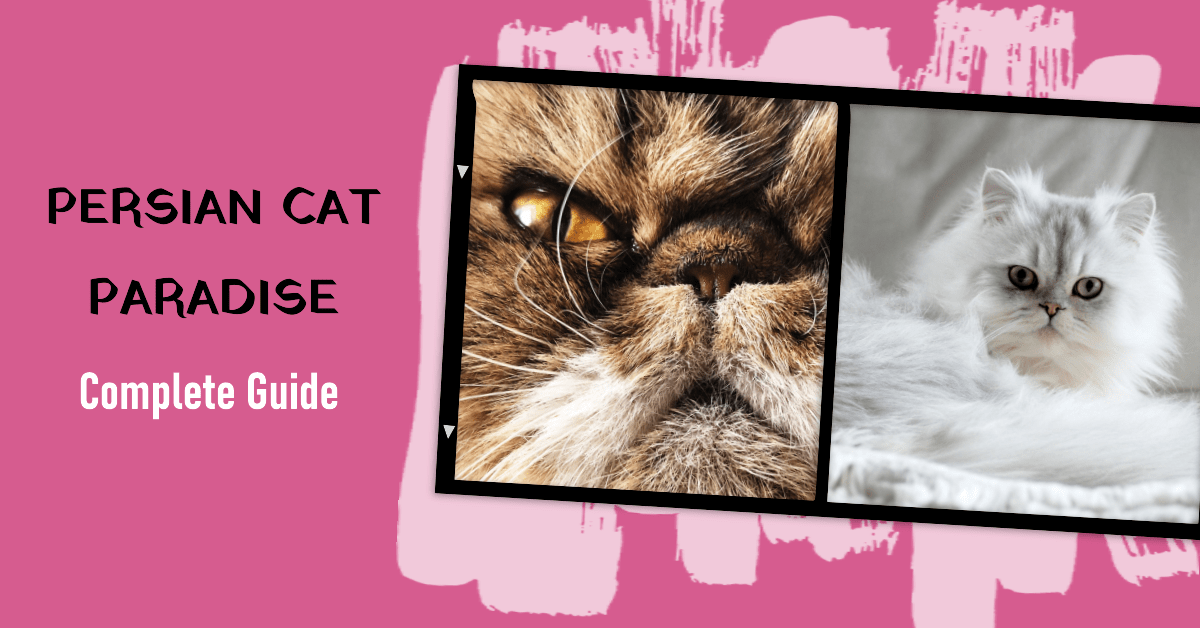
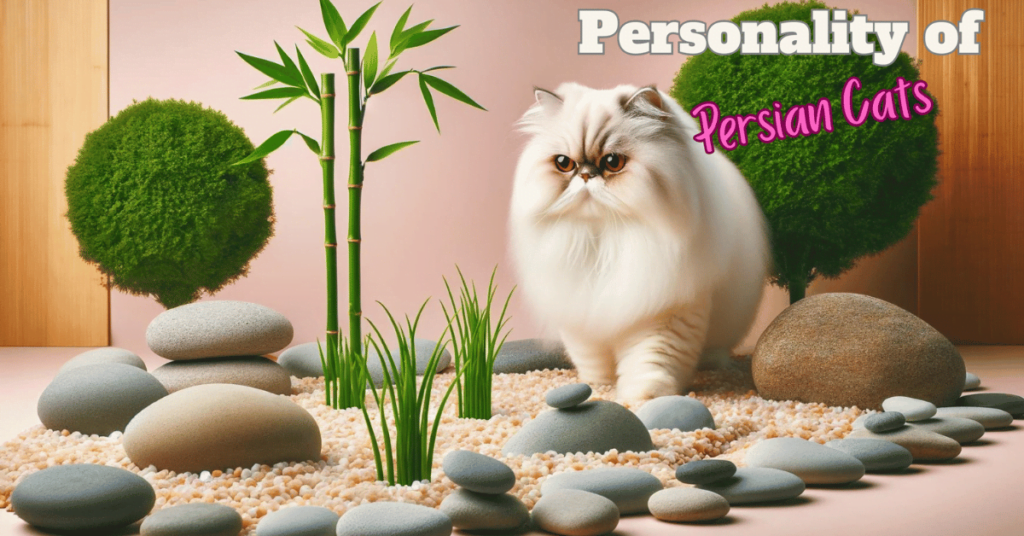
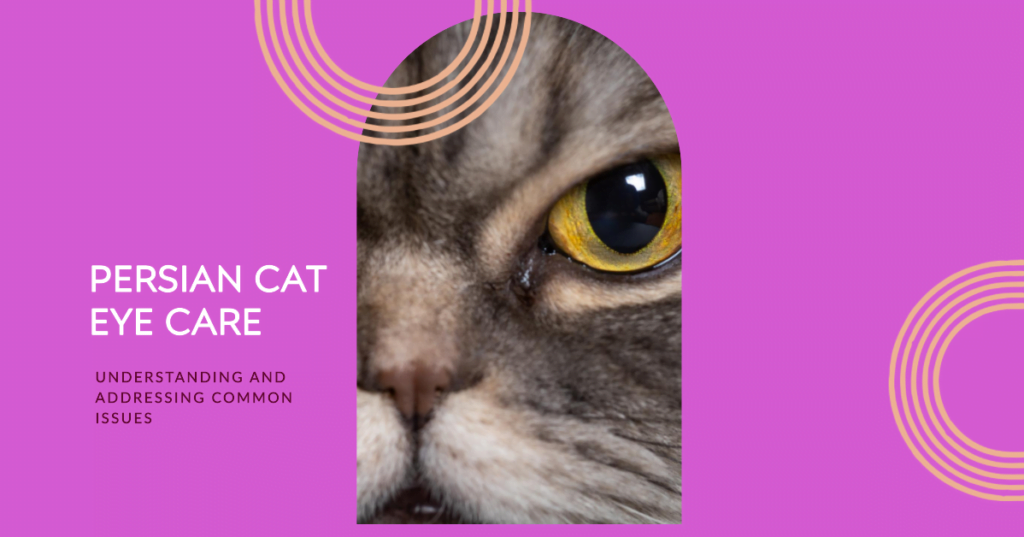
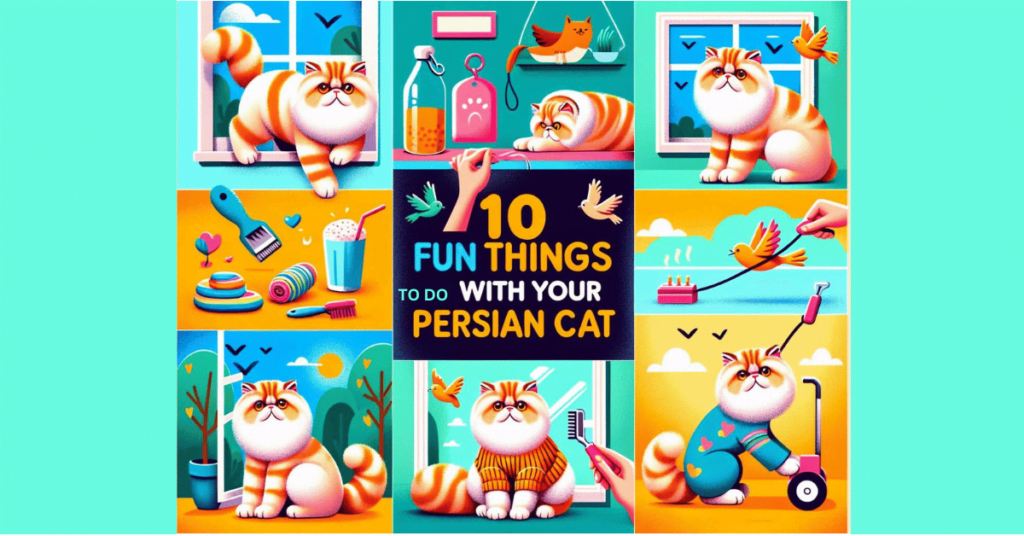


Leave a Reply